Planet Killers
Written: 2002-06-23
Last Revised: 2002-11-24
We sci-fi fans seem to have a morbid fascination with weapons of mass destruction. And since every starship seems to be equipped with them, weapons of mass destruction don't have the kind of "ultimate weapon" atmosphere that we need. Nuclear weapons and other weapons of localized mass destruction are terrifying in real life, but ho-hum in sci-fi. We're jaded, and we want more! Enter the planet-killer.
So what is a planet-killer? A planet-killer is something that literally "kills" an entire planet, ie- renders it dead. This normally entails such a profound level of surface destruction that all civilization on the planet's surface is destroyed. In some cases, they go further, and completely sterilize the surface. In the most extreme cases, they actually destroy or consume the physical bulk of the planet itself, thus making them true planet destroyers.
In fact, planet-killers are so common in sci-fi that a complete list would be simply overwhelming, and even the most superficial discussion would be well beyond the scope of this page. Therefore, I will restrict myself only to discussion of planet-killing objects, ships or weapons that have been seen in big-name TV or movie-based sci-fi franchises like Star Trek, Star Wars, etc.
This means, among other things:
No obscure sci-fi universes based on novels, comics, animes, computer games, etc. If you want something to be included, tell the author to convert it into a popular movie or TV show and then get back to me. And yes, I'm also excluding computer games based on TV shows and movies; such games are designed for playability and entertainment, not accuracy to the source material.
No "godlike beings". This page is about weapons, not demigods. I don't really care about how your favourite demigod could destroy a world with the power of his mind. As an aside, I have noted that people often assume a "godlike being" (such as Q) must be capable of destroying a planet even though we've never seen him do anything remotely approaching this. They seem all too willing to make the unfounded leap in logic from "does things I don't understand" to "omnipotent".
No great swarms or fleets of ships. Virtually anything can theoretically depopulate a planet given enough sheer numbers (even buckets of water). A planet-killer (singular, not plural) is a single object, ship, or weapon.
I'm sorry if I have excluded your favourite example by narrowing the list down like this, but without some exclusions, this page would simply be enormous.
Planet Killers
Asteroid or comet impact | Cobalt Bomb | Shadow planet-killer
Vorlon planet-killer | Imperial Star Destroyer | Republic Acclamator
Eclipse-class Star Destroyer | Genesis Device | ForeShadow
Planet Destroyers
Death Star | Death Star 2 | LEXX
World Devastators | Galaxy Gun | Doomsday Machine
Species 8472 | Drej Mothership | Supernova Weapons
Planet Killers
Asteroid or comet impact (real-life)
You don't need to watch sci-fi to learn about the awesome power of a planet-killer. A sufficiently large asteroid or comet impact could theoretically devastate a planet's surface in real life, and our planet bears mute testimony to such impacts, with many large craters scarring its surface. Indeed, if it weren't for erosion and tectonic plate movement, the Earth would look like the surface of the Moon.
Even the smallest asteroid impact can be extremely destructive. The infamous Tunguska blast (estimated yield: ~1000 times the Hiroshima blast) was thought to have been caused by a mere 50 metre wide asteroid, which would have easily fit into a football stadium!
The destructive power of a large asteroid impact is truly horrifying. If we assume a silicaceous asteroid with an average density of (for example) 2700 kg/m³, a 30 km wide asteroid moving at typical Earth-crossing velocity of 25 km/s would hit our world with the kinetic energy equivalent of nearly three billion megatons of TNT. This is a number which is so staggeringly large as to beggar the imagination; just try to imagine detonating a Hiroshima bomb every second for more than six thousand years, and then compressing all of that into a single titanic blast.
|
Impact Energy |
Result1 |
|---|---|
|
1E5 to 1E6 megatons |
Land impact destroys a large state (eg- California, France, Japan) and produces enough atmospheric dust loading to affect global climate, freezing crops. Ocean impact creates hemisphere-spanning tsunamis but no global climate change. Global ozone layer is heavily damaged. |
|
1E6 to 1E7 megatons |
Both land and ocean impacts produce enough atmospheric dust to affect global climate, freezing crops. Impact ejecta are globally distributed, causing widespread fires. Land impact destroys a large nation (Mexico, India). |
|
1E7 to 1E8 megatons |
Probable mass extinction event. Global climate changes last for weeks or months. Direct destruction occurs on continental scale (Australia, United States). Massive global firestorms. The K-T extinction event 65 million years ago fell into the upper end of this category. |
|
1E8 to 1E9 megatons |
Large mass extinction event. Most of the Earth's biosystem is destroyed. |
|
>1E9 megatons |
Global extinction event. All complex forms of life probably destroyed. |
One of the most common misconceptions regarding asteroid impacts is that they do all of their damage through stratospheric dust loading. This is not true; asteroid impacts can damage or exterminate a biosystem through a variety of mechanisms:
Wake radiation. A large asteroid or comet will create an enormous "bow wave" of superheated, ionized gas in front of it as it passes through the atmosphere, and it will leave a "wake" of superheated, expanding gas behind it. The wake can be modelled as a cylindrical explosion, with the effects of a conventional nuclear fireball: shockwaves, intense thermal radiation, etc. Moreover, the height of the elongated fireball column means that much of this radiation will propagate through upper-atmosphere layers which are essentially transparent to thermal radiation, so it will have much more widespread effects than a surface-level nuclear explosion of equivalent yield. In fact, it is theorized that massive casualties on a continental scale may be caused by wake radiation alone, even before a massive impactor hits the ground.
Impact groundquake. Like a hammer-blow, an asteroid impact will produce powerful seismic shockwaves that propagate directly through ground matter. These seismic shockwaves will cause a vast region of destruction (hundreds or thousands of kilometres wide) in any case, but they are particularly destructive to human civilization, especially major cities with their large scaled structures and sensitive installations such as chemical plants, nuclear power plants, toxic and/or radioactive waste storage facilities, biological and chemical weapons research laboratories, etc.
Impact fireball. In addition to the columnar fireball produced by the impactor's hypervelocity passage through the air, there is a huge fireball produced by the violent release of kinetic energy upon impact. This fireball is similar to that created by a nuclear explosion, with powerful atmospheric shockwave (or underwater shockwaves for ocean impacts, although these don't travel as far) and thermal radiation effects. The fireball tends to be drawn up into the ionized wake, so it takes on more of an elongated vertical shape than a spherical nuclear fireball. It should be noted that these effects scale according to the inverse square law for radiation and the inverse cube law for shockwaves, so the radiation effects easily outstrip the shockwave effects for large-magnitude impacts.
Tsunami. A large-body ocean impact vapourizes a column of water, thus producing a "hole" in the ocean. A column of vapourized water is hurled into the stratosphere, and an enormous water wave is created. This water wave moves outward from the impact site until it reaches the shore, whereupon it loses speed and gains height, thus causing a height increase of 10 to 20 times. Numerical simulations of an ocean impact by a 10 km wide stony asteroid with a velocity of 20 km/s have led to the conclusion that the resulting tsnumai would be a staggering four kilometre high water wave a thousand kilometres away! Unlike atmospheric shockwaves, tsunamis scale according to the inverse square law rather than the inverse cube law, so ocean impacts are actually more destructive than land impacts, particularly since human civilization tends to concentrate at shorelines rather than inland regions.
Ballistic impact ejecta. A large asteroid impact tends to produce more melted and vapourized particulate debris than a nuclear explosion, and much of this debris is hurled upwards as a hypervelocity plume. Much of it is hurled well beyond the atmosphere and into space, whereupon it eventually falls back into the atmosphere due to gravity at speeds similar to its ejection speed (up to 5 km/s). Like any other hypervelocity atmospheric entry object, the condensed and coalesced debris particles will ablate from air friction, thus re-heating them and the atmosphere. These processes have the effect of converting the kinetic and thermal energy of ejecta into globally distributed thermal radiation and elevated upper-atmospheric temperatures, thus igniting global firestorms and altering the climate. Extremely large impacts (tens of billions of megatons) can produce so much high-energy ballistic ejecta that the entire atmosphere will be radiatively heated beyond 1500K, in which case all other damage mechanisms essentially become irrelevant because the planet is completely sterilized.
Acid rain. Hypervelocity shockwaves produce NO (nitrogen oxide) because of chemical reactions in the energetic "shocked air". Such shockwaves are produced three times: once by the impactor's passage through the atmosphere, again by the movement of its ejecta plume up into space, and yet again by the re-entering ballistic hypervelocity ejecta. NO can also be produced if the impact happens to strike a sulfate or carbonate-rich area of the surface. The result would be ozone layer destruction (much more than for nuclear explosions) and a global increase in acidity of surface waters, which would provide yet another environmental damage mechanism. It would take many years for the NO loading of a large impact to be removed from the atmosphere.
Water injection. A large hypervelocity impactor can produce a towering column of water and steam which reaches up over 100 km in altitude, and which contains 10 to 30 times the mass of the impactor. This has the effect of literally humidifying the entire upper atmosphere, but the effects of such humidification are not known. Cloud particles can produce a runaway greenhouse effect or they can reflect sunlight, but these particles can produce heating or cooling effects depending on their size.
Electrodynamic interactions. The ionized wake, ionized hypervelocity ballistic ejecta plume, and consequent atmospheric shockwaves of a large impactor will all contain ions (obviously). The ionized jet will interact with the Earth's magnetic field to create a giant magneto-hydrodynamic generator which alters the shape of the magnetosphere and converts the jet's kinetic energy into thermal energy in the ionosphere. This will destroy the ozone layer and disrupt the Van Allen belts, with unknown but probably detrimental effects upon the biosystem.
Atmospheric dust loading. This is the most famous consequence of an asteroid impact. Much of the ballistic ejecta plume condenses into tiny droplets which are small enough to remain suspended in the upper atmosphere for months, blocking sunlight and cooling the Earth, as well as disrupting plant photosynthesis.
It should be noted that nothing in our direct experience could prepare us for such phenomena, because some of them are a direct result of the sheer size and concentration of the effects. Even the largest nuclear weapons in human history (~60 megatons) only cause two of these eight phenomena; they do not produce wake radiation, tsunami, sub-orbital ballistic ejecta, acid rain, upper-atmospheric water injection, large-scale electrodynamic interactions with the Earth's geomagnetic field, or significant stratospheric dust loading2. This limitation is due largely to their relatively insignificant yields, since many of these effects are dependent upon an extremely large release of energy in one concentrated place at one time.
Cobalt bomb (real-life)
The cobalt bomb is an idea which dates back to the early Cold War, and which was made famous in science fiction films such as the Planet of the Apes movies. The basic principle is that if a nuclear weapon is encased in cobalt, it will produce significant quantities of the Cobalt-60 radioisotope, which is radioactive enough to pose a serious threat, but long-lived enough to render territory effectively uninhabitable. This was extrapolated to the "planet-killer cobalt bomb", which would supposedly render the entire Earth uninhabitable.
However, the threat of the cobalt bomb is seriously exaggerated. There are limits to how much Co-60 a single bomb can be expected to produce, and even a large number of bombs cannot produce enough cobalt to kill the world's population. We need to remember that the toxicity of Co-60 is such that we would consider contaminated territory uninhabitable, but territory need not be 100% lethal in order for us to consider it uninhabitable.
In other words, a very large number of Co-60 bombs might render large portions of the Earth's surface uninhabitable, but that only means there would be an elevated cancer risk in those areas for many years; it does not mean that the entire population would die. A cobalt bomb does not really qualify as a planet-killer at all, but it is included here simply for the sake of discussion, and because it is so widely known.
Shadow planet-killer (Babylon 5)
Concept
The Shadow planet-killer is a giant spaceborn MLRS (multiple-launch rocket system) concealed within an energy-draining cloud. Some Babylon 5 fans claim that this cloud is composed of nano-bots, but that seems absurd. Nano-scale constructs (either mechanical or biological) have an extremely low "thermal capacitance", which is an engineering short-hand way of saying that their ratio of mass to surface area is extremely low, so they heat up very quickly in the presence of radiation (yes, size matters). In other words, thermal radiation which would be harmless to a conventional vehicle or even human skin would rapidly heat nanobots to the point of destruction (this is why microbial life forms must encase themselves in spores or they won't even survive sunlight). The radiative output of a single megaton-class nuclear weapon would destroy all of the nanobots in a volume of space encompassing at least many tens of thousands of cubic kilometres. Only a lunatic or a fool would build a superweapon out of a cloud of nanobots.
The size of this network is unknown, but when it approaches Earth, it does not appear to be of planetary scale. However, it is widely claimed that it completely envelops an entire planet. If true, it means that the cloud must be very widely spread out in the process, since it was mostly empty space on its approach to Earth, and it had not even fully deployed yet. This would imply that there is a lot of empty space between each active missile-firing web-node when it is fully deployed. An enveloping mesh would scale according to the inverse square law. Therefore, if the cloud is 100 km wide before deploying and 15,000 km wide afterwards, the amount of empty space between nodes should increase by a factor of 22,500. In other words, there should be many tens of thousands of kilometres between active missile-firing nodes in the cloud.
As is all too common in science fiction, this weapon has an Achilles Heel. One of the nodes is a "control centre", and its destruction causes the destruction of the entire cloud along with all of its associated nodes. This was how the allied fleet was able to destroy the Shadow planet-killer in "A Call to Arms". However, it had a lot of heavy guns to destroy even the heaviest warships before they could hit this point (and they proved effective), so a smarter method would have been to send vast swarms of fighters into the cloud (ie- overrun the defenses with sheer speed and numbers) in an effort to locate the vulnerable node, and then have them act as forward artillery spotters, to relay its co-ordinates to high-powered long-range weapon platforms sitting outside the cloud.
There is some question as to the intelligence of the designers; why build a weapon which must disperse itself over such a huge area in order to accomplish the mundane task of firing missiles at it, when you could simply fire a swarm of guided missiles from a conventional starship? To prevent escape? That seems a ridiculously convoluted way to prevent escape; why can't a fleet of ships simply blockade the world? Why is the entire cloud controlled from a single control centre, with no redundancy? Amazingly enough, it actually has a second control centre, but it is a non-functional decoy! Why go to the bother of constructing a second control node which looks exactly like the first one, and not give it the ability to take over in the event the first one is destroyed? The intelligence of the Shadows is questionable for other reasons as well; for example, they have been aware of a telepath vulnerability in their basic warship design for more than a thousand years (telepaths can jam their warships, thus stopping them cold), yet they have done nothing whatsoever to remedy this crippling design defect.
Known Effects
A Whitestar under the command of a Ranger named Ericsson sent back video of a Shadow planet-killer attack, in which we could see clusters of missiles being fired from one of the misile-firing nodes. A transcript of Ericsson's report follows:
Scanners indicate the missiles have penetrated the surface of the planet.
Burrowing straight down.
Ten miles.
Twenty.
I don't believe it, they're nearly through to the molten core of the planet.
Wait, they've stopped. It's ...
(interference)
Electromagnetic pulse coming from the surface. We caught a piece of it. The missiles have detonated near the planet's core. Thermonuclear reaction. Thousands of megatons times thousands of missiles. The planet's core is breaking up. We're registering massive tectonic movement, atmospheric disruption ... it's falling apart from the inside out. In another ten, twelve hours there won't be anyone left alive down there.
Note the erroneous terminology; the missiles burrow ten miles below the surface, then twenty, and they're already near the "molten core?" Does Ericsson realize that once you get through the solid crust, the molten stuff is called the mantle, not the core? I guess they don't teach geology in Ranger school. Worse yet, he claimed that the core was "breaking up". What does it mean for a molten substance to "break up"?
In any case, his sensors are probably more reliable than his interpretations of geological events, and he registers huge thermonuclear explosions of "thousands of megatons", seismic disturbances, and atmospheric ejecta, all of which are consistent with sub-surface explosions which are close enough to the surface to cause cratering and injection of matter into the atmosphere. The electromagnetic pulse (so powerful that it affected a starship in high orbit) is consistent with surface breakthrough; a completely buried subsurface explosion will produce a weak electromagnetic pulse, and the pulse from a blast deep inside the mantle of the planet would be muffled by the huge quantities of ferrous material between the blast and the surface. The burrowing action of the missiles is probably intended only to increase the cratering and seismic effect of the bombardment, perhaps for the purpose of destroying underground facilities such as mines and bunkers.
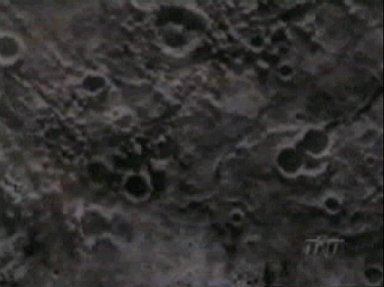 Sheridan
observed large craters from orbit around Daltron 7, another planet
victimized by the Shadow planet-killer (at right, image poached from
Babtech on the Net). This
is consistent with the mechanism described above. The need for
cratering and surface break-through is probably why the missiles
stopped short; if they continued to go deeper (ie- if they had
continued deep into the molten mantle), they would not produce
surface cratering.
Sheridan
observed large craters from orbit around Daltron 7, another planet
victimized by the Shadow planet-killer (at right, image poached from
Babtech on the Net). This
is consistent with the mechanism described above. The need for
cratering and surface break-through is probably why the missiles
stopped short; if they continued to go deeper (ie- if they had
continued deep into the molten mantle), they would not produce
surface cratering.
A 20 mile (32 km) deep crater in surface silicates (assuming hard granite) requires roughly 50 gigatons, so this implies that each missile has 50,000 megatons of yield. This is a bit large for "thousands of megatons", but perhaps we shouldn't read too much into Ericsson's choice of words, given his confusion of geology terms. In any case, as you can see from the image, the craters on Daltron 7 were spaced somewhat randomly, with some clustered so closely together that they overlapped, while others were separated by smooth areas of more than five times their diameter. If we assume the crater spacing was three times their diameter on average, the craters would be roughly 200 km apart. Global crater spacing at this density would add up to roughly 13,000 missiles. It is possible to generate different figures by assuming larger craters, but the crater spacing means that 50% larger craters would also mean 50% fewer craters. Moreover, realistic crater depth estimates are limited by the thickness of the planet's crust (~40 km average for Earth) and the fact that Sheridan saw solid craters rather than gaping volcanic holes in the crust of Daltron 7.
Therefore, the Rangers' sensor readings and our observations of Daltron-7's surface indicate that a Shadow planet-killer has a total yield of approximately 13,000 missiles times 50,000 megatons, which works out to roughly 650 million megatons (although one should keep in mind the limited accuracy of these observations; the figure should realistically be used as an order-of-magnitude estimate rather than a precise specification, ie- think of this only as evidence for the 1E8-1E9 megaton range).
This is many times the yield of the infamous K-T extinction asteroid, which seems excessive in light of the fact that Sheridan could walk around comfortably and see without night-vision goggles on Daltron-7's surface mere days after an attack (ie- sunlight was not blocked out by atmospheric dust and atmospheric heating was negligible). Moreover, Ericsson's estimated 10-12 hour depopulation timeframe is much too long for a methodical attack of such violence. These facts put limits on the maximum yield, but these problems can be mitigated slightly by noting that the depth of the explosions would have channeled most of their energy into cratering and seismic effects rather than high-velocity ejecta (although sufficiently violent cratering and seismic activity would leave its own symptoms, and cause its own problems for the 10-12 hour timeframe).
Vorlon planet-killer (Babylon 5)
Concept
The Vorlon planet-killer is a warship, approximately 5 miles long. Its capabilities were never demonstrated onscreen, as we never saw it actually fire its weapons on a planetary surface. We know almost nothing about its limits or even the method in which it attacks a planet. We know only that it is said to be a planet-killer, and that planetary civilizations attacked by it are "gone" afterwards. This is something of a disappointment; when one considers the dramatic sequence in which we were introduced to this vessel, it is hard to believe they would never show us what it can do.
Vorlon ships fire by creating an energy web between their forward tendrils, which then forms into a forward-firing energy beam. The Vorlon planet-killer has only one set of tendrils, so this indicates that it has only one large weapon. It appears to be a purpose-built weapon rather than a warship, since a warship of that size would need to have smaller weapons which can be aimed at targets surrounding the ship. Given that design intent, it should not come as a surprise that its defensive capabilities were lacking, and that a Vorlon planet-killer was destroyed onscreen by a swarming fleet attack, with no need to locate and strike a vulnerable Achilles Heel (unlike the Shadow planet-killer).
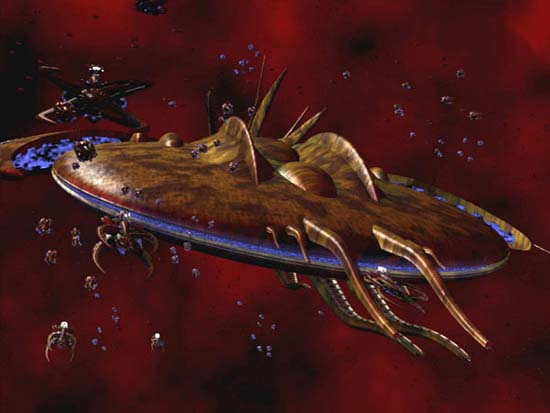
Known Effects
It is difficult to imagine that the Vorlon planet-killer would be more destructive than the Shadow planet-killer, since it is much smaller than the Shaow planet-killer and the two races seem to be of similar technological levels. In fact, observations suggest that it is less destructive. While we did not see the aftermath of a Vorlon planet-killer attack for ourselves, Ivanova called for an evauation of survivors from one such attack. The transcript of her distress call follows:
Survivors indicate mass destruction on a planetary scale. We continue to need medical ships, transports, anything that can fly. We are in special need of atmosphere-capable shuttles to evacuate survivors from the ground.
This obviously means that a Vorlon planet-killer performs an incomplete sterilization. If we assume that it sits in orbit and simply blasts the planet with a high-powered energy beam, its output cannot exceed the 1E8-1E9 megaton range of the Shadow planet-killer or we would see too much atmospheric heating and thermal radiation from re-entering sub-orbital ejecta to have any survivors on the ground. The 1E7-1E8 megaton range is probably more realistic.
Imperial Star Destroyer BDZ (Star Wars)
Concept
An ISD is capable of rapidly exterminating all life on the surface of an entire planet, in a massive orbital bombardment known as a Base Delta Zero operation. No planetary inhabitant would wish to look through a telescope and see this:
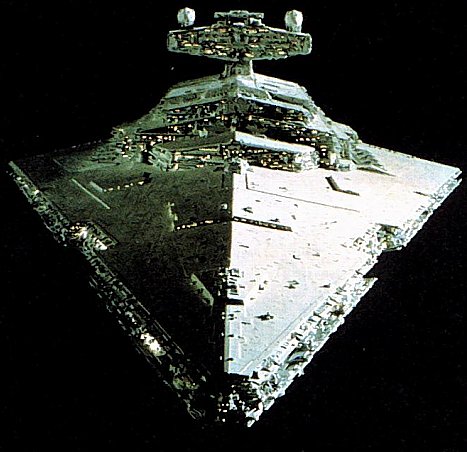
Known Effects
See the dedicated Base Delta Zero page.
A BDZ leaves no survivors at all, hence no witnesses. Only a "deep planet shelter" can protect someone from a BDZ operation, which is so savage that three ISD's working in concert can blast the entire atmosphere away, leaving its surface a barren, "evenly cratered" airless wasteland (and even a deep planet shelter is still potentially vulnerable if a shot happens to hit directly overhead, hence some uncertainty about survivability even in such a shelter). The 1E8-1E9 megaton range of the Shadow planet-killer is a fairly conservative range for BDZ firepower. According to the SW2ICS, fleets of warships (typically 100 ships according to other official sources) conducting this kind of operation will actually melt the entire upper crust of a targeted world, although that is far beyond the requirements of a single planet-killer operation, of the kind that a lone ISD would typically perform.
Note: I have been repeatedly made aware of the fact that some Babylon5 fans bristle at the idea that a single ISD is at least as powerful as a Shadow planet-killer. However, that's simply too bad; deal with it. An ISD BDZ leaves no survivors, which makes it as destructive as a Shadow planet-killer (but requiring more energy since it uses beam weapons instead of more efficient explosive warheads), and more destructive than a Vorlon planet-killer. If you think this unreasonable or contrary to the canon films, just remember that AOTC proved that superlaser technology predated the Empire and was so commonplace that it was used in ground weapons, so try scaling a Death Star blast down to ISD size.
Republic Acclamator orbital bombardment (Star Wars)
Concept
A Republic Acclamator is nowhere near as powerful as an Imperial Star Destroyer, with a tenth of the larger ship's volume and a much smaller fraction of its interior space devoted to power generation and weaponry. It is most likely two orders of magnitude less powerful. However, the Republic-era Acclamator was still more than powerful enough to devastate a planet's surface through conventional orbital bombardment.
It is not known whether an Acclamator can unleash simultaneous full broadsides from both sides (it would have to invert to bring the planet's surface within the firing arc of both sides' turrets), but even if we assume that it staggers its firings (as refit Iowa-class battleships do), this would merely spread the total yield over a period of several seconds. The overall effect would not be significantly altered.
Known Effects
Given the fact that an Acclamator has two orders of magnitude less volume devoted to equipment, one would expect its firepower to be two orders of magnitude below Star Destroyer firepower, ie- 1E6-1E7 megatons instead of 1E8-1E9 megatons.
Therefore, it is not surprising that its official firepower specifications (not including its heavy forward strategic torpedo launchers or light guns) are 200 gigatons per shot for each of its 12 quad-turbolaser turrets. That is 12 x 200 = 2400 gigatons, or 2.4E6 megatons. Given a comparison to asteroid impact effects, we should expect the detruction of sub-continental nation-states as well as global climate changes and wildfires scattered over the planet's surface, although we should keep in mind that there will be some differences between the effects of a beam weapon impact and an asteroid impact (for example, a beam weapon should spend more of its energy drilling down into the planet's crust). An Acclamator also has four "heavy strategic missile and torpedo launch tubes" of unknown yield, presumably to make up for its strategic deficiencies relative to larger warships. The fact that its tactical weapons have 200 gigatons yield strongly suggests that its "heavy strategic" weapons are much more powerful, perhaps one or two orders of magnitude. This could potentially elevate an Acclamator's firepower up to ISD level, but such large missiles might be easily shot down in flight.
Eclipse-class and Sovereign-class Star Destroyer (Star Wars: Dark Empire)
Concept
Eclipse and Sovereign-class Star Destroyers mount smaller versions of the Death Star's fearsome superlaser. There are various conflicting reports on its power. Some sources say that it has two thirds the power of the Death Star's superlaser, while other sources say it has one seventh its power. However, both figures appear to be exaggerated; even one tenth the Death Star's power would easily destroy an entire planet, which is beyond the capabilities of an Eclipse of Sovereign-class ship.
Known Effects
According to the official literature, the Eclipse-class Star Destroyer's superlaser is capable of "cracking the crust" of a targeted world and "searing continents" off its surface. It goes without saying that such a large superlaser should be much more powerful than an Acclamator or an ordinary ISD, and the energy requirement for vapourizing an entire continent is well in excess of the threshold for a global extinction event (1E9 megatons). Figures in the range of 1E10-1E11 megatons are probably more realistic. The radiative heating effect and the enormous volume of ballistic ejecta produced by such an event would undoubtedly heat the entire atmosphere up well beyond the point of total sterilization, so it is unlikely that any forms of life would survive.
Genesis Device (Star Trek II: The Wrath of Khan)
Concept
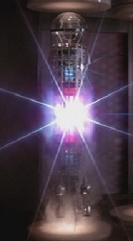 The
Genesis Device is a 2 metre long torpedo which apparently contains an
unusual application of transporter technology. According to Carol
Marcus, it can rearrange an entire planetary surface at the
"subatomic level", in order to create a new biosystem
(although her grasp of the underlying mechanism may be suspect, since
it turned out that it was entirely dependent upon unstable
"proto-matter" technology for its mysterious
matter-transmutation capabilities, and she had no idea). It is, in
effect, a high-speed terraforming system. Unfortunately,
"proto-matter" is apparently unstable, which means that the
resulting biosystem lives on borrowed time. The Genesis Device is
also a planet-killer, which Kruge referred to as an "ultimate
weapon" because any indigenous life would be destroyed.
The
Genesis Device is a 2 metre long torpedo which apparently contains an
unusual application of transporter technology. According to Carol
Marcus, it can rearrange an entire planetary surface at the
"subatomic level", in order to create a new biosystem
(although her grasp of the underlying mechanism may be suspect, since
it turned out that it was entirely dependent upon unstable
"proto-matter" technology for its mysterious
matter-transmutation capabilities, and she had no idea). It is, in
effect, a high-speed terraforming system. Unfortunately,
"proto-matter" is apparently unstable, which means that the
resulting biosystem lives on borrowed time. The Genesis Device is
also a planet-killer, which Kruge referred to as an "ultimate
weapon" because any indigenous life would be destroyed.
Known Effects
The Genesis Device's energy requirements are impossible to determine. Thermodynamic energy balances severely limit any energy state increase, for the simple reason that the energy state must be low enough to support a biosystem. In other words, too much energy would make the resulting world uninhabitable, since it can't have a superheated atmosphere or hundreds of billions of tons of matter hurled up to extreme altitudes (unlike the aftermath of a large asteroid impact or massive orbital bombardment). However, since there is no known net energy state increase required by its implicit transporter-based physical reorganization, there is no lower limit to its energy requirement.
The Genesis Device was only used once, in the Mutara Nebula. It converted the nebula into a planet: an act which actually required negative energy, because the gravitational potential energy state of the resulting planet was much lower than that of the nebula. In fact, the missing GPE seemed to disappear without a trace, thus leading to serious questions about its eventual destination. There are numerous theories: time dilation, mysterious proto-matter submersion of excess energy, disappearance into subspace (the standard Trekkie excuse for scientific gaffes), etc. Unfortunately, these theories are purely speculative, and there is precious little information to clarify the picture. Since the only prototype was destroyed and its plans erased, it would appear that this situation will be permanent. We don't even know its effects upon a typical world, as opposed to a nebula, nor do we know if it would affect a shielded planet at all (remember that transporter beams don't penetrate shields).
Fore-Shadow (LEXX)
Concept
The Mega-Shadow was the personal flagship of His Divine Shadow for more than two thousand years. We saw it at the beginning of LEXX, when it exterminated the Brunnen G. It is a relatively small beetle-shaped starship, perhaps one mile in length although I haven't performed detailed scaling. When it attacks, it unfurls a large web-like structure, so that it is several miles wide. As you can see in the accompanying picture, the web structure launches some kind of energetic web-shaped projectile at its target (notice the solid, dark structure and the brightly glowing web which is being launched forward). It bombards a planet with these energetic webs until its surface is reduced to molten slag.
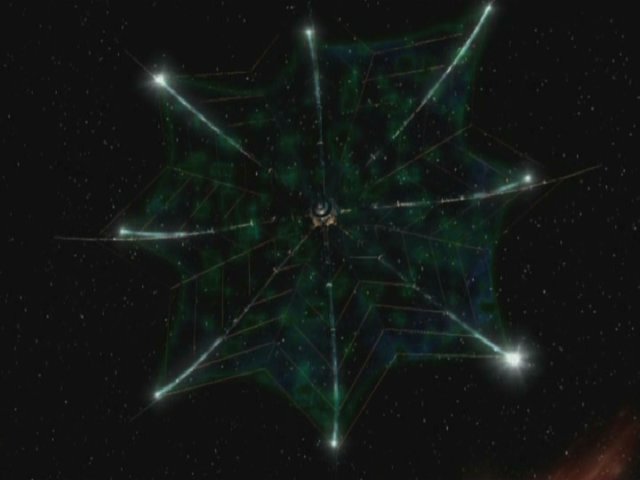
Known Effects
The web appeared ephemeral, but its effects upon the target were all too real. In the picture below, you can see a brightly glowing region where one web has already struck the surface (to the lower right), as well as a second web on the way.
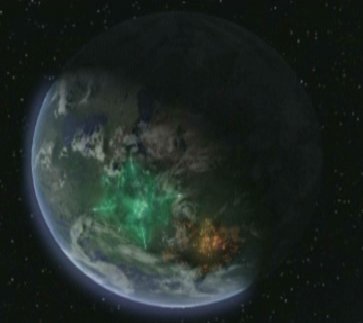
Each web grows as it approaches the planet until it is capable of affecting a region roughly 2500 km wide (based on the picture), and the ForeShadow can fire roughly one web every two seconds. At this rate, it can cover most of the facing hemisphere in less than one minute, although regions to the sides would experience much greater dispersion because of the incident angle. The ForeShadow did not bother maneuvering to hit the opposite side of the planet, presumably because the global effects of the devastation on the facing side were deemed more than sufficient to achieve total depopulation. The picture below is the result of the ForeShadow's assault after roughly 70 seconds (35 webs):
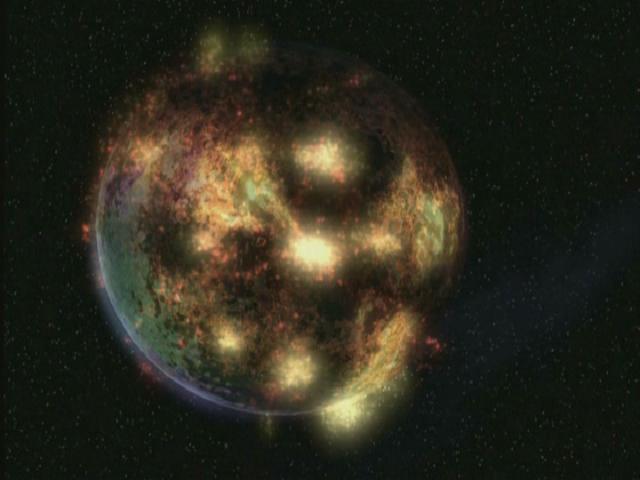
There can be little doubt that this bombardment resulted in total planetary depopulation. The brightly glowing surface areas indicate vast regions of the crust which have been molten and/or vapourized, along with atmospheric superheating and many of the other effects we would expect for such a violent bombardment. Notice that you can actually see superheated planetary crust being blown into space, as it would be from a violent asteroid impact (note to Trekkies: this is what it should look like when you bombard a planet violently enough to seriously damage its crust; the piddly bombardment in "The Die is Cast" does not even begin to approach this). The ForeShadow's armament is considerably more destructive than the weaponry of Shadow planet-killers, Vorlon planet-killers, or Imperial Star Destroyers.
If we assume perfect efficiency and 1 km melt depth across 50% of the facing hemisphere's surface area (which seems fairly conservative, given the level of destruction seen above), we're talking about energy in excess of 1E11 megatons: many orders of magnitude above the requirement for mass extinction.
PS. Yes, I'm aware that Lexx probably doesn't qualify as a "big-name" sci-fi franchise, so it should not technically be included. But I really like Lexx, and this is my website, so there.
Planet Destroyers
Death Star (Star Wars Episode IV: A New Hope)
Concept
Shoot gigantic moon-sized raygun at planet. Watch planet go boom.
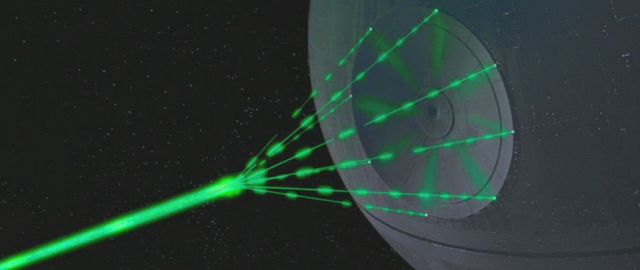
Known Effects
See the Alderaan page.
The absolute minimum energy requirement for destroying an Earth-like planet is roughly 5E16 megatons. This is 500 million times the K-T extinction asteroid impact (and hundreds of millions of times the firepower of an individual ISD or Shadow planet-killer). However, this does not even come close to the firepower of a Death Star. 5E16 megatons would just barely overcome gravity, and the planet would expand so slowly that it takes ten minutes to double in size. Obviously, the destruction of Alderaan exceeded this quantity by many orders of magnitude. In fact, an energy estimate derived from Alderaan's rate of expansion leads to an estimate in the 1E22 megaton range (yes, that's at least 100 trillion times the K-T extinction asteroid impact, or as much energy as our Sun has generated since the time of Moses).
Death Star 2 (Star Wars Episode VI: Return of the Jedi)
Concept
Identical to the first Death Star, but it added the ability to fire off-axis, so that it could use its superlaser to target capital ships. Obviously, no capital ship could possibly survive a direct hit from a Death Star superlaser. This one had no "thermal exhaust port" Achilles Heel, and its heat dissipation had been greatly improved, so that it could fire every few minutes instead of every few hours.
An aside, it should be noted that there were numerous other Death Stars in addition to the two famous Death Stars. A Hutt crime syndicate built Darksaber, which was a bare-bones Death Star with no armoured shell, shielding system, or defensive weaponry. There were also one or two prototype models.
Known Effects
According to the opening scrawl of ROTJ, the second Death Star is even more powerful than the first, but we never saw it fire on a planet so we have no way of knowing how much more powerful it was. It was many times the first Death Star's size, so this implies at least an order of magnitude firepower increase. However, firepower of this magnitude becomes virtually meaningless, because there is no longer any question of whether it will penetrate a warship's (or planet's) defenses, so the larger advantage of DS2 is its off-axis firing capability, not its sheer firepower for a max-yield shot.
Lexx (LEXX)
Concept
The Lexx was intended to replace the MegaShadow (which was, in turn, the successor to the ForeShadow) as the personal flagship of His Divine Shadow, supreme overlord of the League of Twenty Thousand Planets. It was a large (several miles long) dragonfly-like vessel which was partially metallic and partially organic (there's that "organic technology" sci-fi chic again). Its "eyes" unleashed a tremendous planar blast which moved through space and split objects at the point of intersection, in a manner somewhat reminiscent of Jango Fett's seismic charges but on a much larger scale. Its power source is unknown; it appears to subsist by literally eating organic matter, but there isn't enough organic matter in an entire planet to fuel one of its planet destroying blasts. Its technological basis may forever remain a mystery, although its destructive power is quite clear.
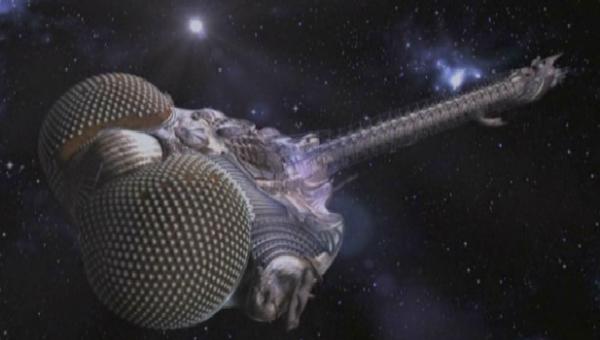
Known Effects
The picture below shows the Lexx's planar blast striking a planet. Debris is hurled away from the point of intersection at tens of thousands of kilometres per second, with expansion velocity approaching that of Alderaan after it was struck by the Death Star's superlaser. It is difficult to evaluate the energy requirement of this attack because of its uneven distribution, but it must certainly be many orders of magnitude above the planetary destruction lower limit of 5E16 megatons. It would not be unreasonable for this vessel's power to be similar to that of the Death Star
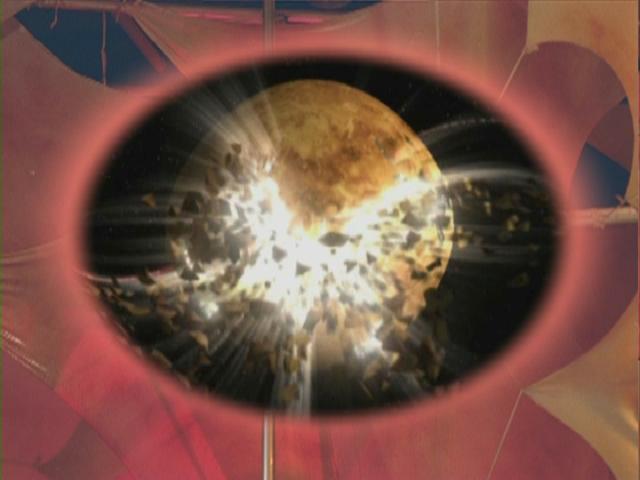
The Lexx is one of the most powerful weapons in science fiction, but its defensive capabilities are weak. It appears to have been designed as a strategic weapon rather than a warship. It has no weaponry whatsoever besides its main forward-firing planet-destroyer. It carries no fighters (it has small unarmed "moth" shuttlecraft), and it has no shields. It has no armour, and physical impactors can easily penetrate its hull, much of which is soft organic material rather than hard metal (if the writers are going to emulate sci-fi chic worship of organic technology, at least it's nice to see them recognizing its inherent deficiencies). These weaknesses have caused the crew no end of troubles, since the ship has been repeatedly boarded.
World Devastator (Star Wars: Dark Empire)
Concept
The World Devastators are planet-destroyers that harvest worlds for their raw materials and then use those materials for fuel as well as manufacturing of starships and fighters. A World Devastator is far less energetic than a Death Star, but it is more constructive; it converts a planet into hordes of starships and fighters and droids over a period of several months.
Like the Death Star, it is a true warship rather than a purpose-built planet-cracker with no defensive capabilities. It can enter into battle with fleets of enemy warships and win, with shields that appear to be impervious to even concentrated heavy turbolaser fire (entire New Republic fleets were unable to cause any damage whatsoever). It can actually consume enemy warships, using enormously powerful tractor beams to pull even Star Destroyers into its maw and harvest them for energy and raw materials.
Known Effects
See the Special Technology page for details.
A World Devastator turns a planet into a debris field. At a bare minimum, this requires 5E16 megatons for an Earth-like planet. It is said to take months in order to accomplish this, although a World Devastator's own fuel reserves need not be so large because it harvests energy from the target planet.
Galaxy Gun (Star Wars: Dark Empire)
Concept
The Galaxy Gun is a long-range strategic missile launcher.
Known Effects
See the Special Technology page for details. A Galaxy Gun missile destroys a planet, but not as violently as the Death Star. As with all planet destroyers, this requires a minimum 5E16 megatons for an Earth-like planet. As with the World Devastators, the "nucleonic chain reaction" employed by the Galaxy Gun suggests that it derives much of its energy from the materials of the targeted world, rather than generating it onboard, the way the Death Star or other classic planet-killers such as Lexx or the Drej mothership do.
Doomsday Machine (Star Trek TOS)
Concept
The Doomsday Machine was a large World Devastator-like planet-cracking machine which resembled some sort of giant slug, with a mouth approximately 1 km wide. According to Spock, it was made of "solid neutronium" (a contradiction in terms; neutronium is inherently fluid, like the nucleus of an atom) and their sensors could not penetrate its surface. Of course, this begs the question of how he could possibly know if the neutronium extended beneath a microscopic surface layer, but that's another story. In any case, it functions very much like the World Devastator, tearing up planets into pieces and processing the material for fuel.
Most of the descriptions are borderline nonsensical. Not only is it supposed to be "solid neutronium", but it supposedly "deactivates" antimatter and fires "absolutely pure" antiproton beams (even though this would cause the machine to suddenly gain a huge negative charge, thus drawing the beam back towards itself).
The Doomsday Machine is similar to the Lexx and the Vorlon planet-killer, in that it appears to be a purpose-built weapon with poor defensive capabilities. While its outer shell easily absorbed phaser blasts without damage, a 97.835 megaton nuclear explosion in its maw rendered it a lifeless hulk. It is no exaggeration to say that this device could be disabled by modern nuclear weapons.

Known Effects
The Doomsday Machine cuts up planets for fuel, but it is unknown how long this process takes, or how much of the planet's mass is actually processed, as opposed to being cast away to drift in space (the iron which makes up most of a typical planet's mass is probably not that useful). However, the Doomsday Machine requires the ability to disintegrate a planet into a floating debris field at the very least, which in turn requires the ability to overcome gravitational potential energy (otherwise the planet would still be intact). This means that the Doomsday Machine does at least 5E16 megatons of work during the process.
Species 8472 bioship cluster (Star Trek Voyager)
Concept
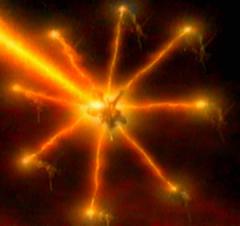 The
Species 8472 bioship cluster was actually a group of "organic
ships" (yes, there's that damned "organic technology is
superior" nonsense again) from a supposedly parallel dimension
with such different laws of physics that all of space is "fluidic"
(of course, Voyager's equipment still worked fine despite being
completely dependent upon the laws of physics in this
universe; I guess the writers didn't think of that).
The
Species 8472 bioship cluster was actually a group of "organic
ships" (yes, there's that damned "organic technology is
superior" nonsense again) from a supposedly parallel dimension
with such different laws of physics that all of space is "fluidic"
(of course, Voyager's equipment still worked fine despite being
completely dependent upon the laws of physics in this
universe; I guess the writers didn't think of that).
The cluster was eight normal bio-ships clustered around a special planet-destroyer ship. This central ship was slightly heavier than a regular ship, with a few extra features on its fins and an extra central protrusion in its nose. It is not known what the function of the clustering action was (apart from an obvious desire to emulate the Death Star's visual style), although the most straightforward theory is that the surrounding ships were supplying extra power to the central ship or reinforcing it somehow. Notice that their beams do not actually combine with the main beam; they hit the central ship itself, so they are obviously not offensive beams; they are presumably power transmission beams instead.
It is commonly assumed that all Species 8472 ships are identical to this ship, but that seems rather silly in light of the visual inconsistencies. Why would this ship look different if it's not special? We have very little information on this vessel, apart from the speculation that it must serve some critical function in their planet destroying operation.
Known Effects
The bioship weapon struck the planet's surface and caused a large ejecta plume, or "plasma jet". This jet happened to be headed almost directly towards a group of Borg cubes in orbit; it was not clear whether this was deliberate or fortuitous.
There was a delay at this point, and then the planet suddenly appeared to explode. This delay is extremely strange; a huge influx of energy cannot simply disappear and then reappear a few seconds later; if it enters the planet's mass, the manifestations should become apparent immediately.
We didn't see the aftermath of the explosion, so we could not verify how much of the planet was given sufficient kinetic energy to overcome gravity. However, if we assume that all of it had sufficient energy to overcome gravity, the energy yield would be the usual 5E16 megatons.
Drej mothership (Titan AE)
Concept
The Drej mothership carried an immensely powerful weapon, similar to that of the Death Star. In the picture below, it appears to be many thousands of kilometres long. However, it appears much smaller in other scenes. I have not examined these scenes closely enough to know whetther the apparent contradiction can be rationalized somehow.
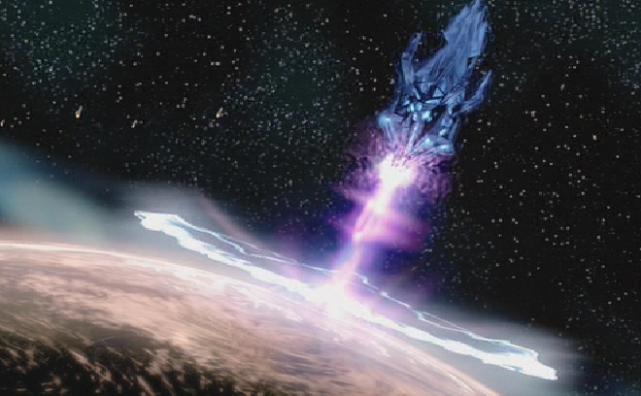
Known Effects
The Drej planet-destroyer had an unusual mechanism; it hit the planet with a beam that seemed to melt the surface, so that it was glowing visibly. Waves of energy passed over the planet's surface, but seemed to do only superficial damage. Then the planet began to spin faster and faster, until it suddenly erupted into an enormous explosion of Death Star proportions. Debris was hurled away at tens of thousands of kilometres per second in every direction, and the Moon was actually shattered by this debris. The Drej planet-destroying weapon is many orders of magnitude above the 5E16 megaton lower limit for planetary destruction, and its yield may be in the 1E22 megaton range, like the Death Star superlaser.
Supernova Weapons
There are numerous supernova-inducing weapons in sci-fi. These weapons are inherently less flexible and useful than planet-killers for numerous reasons. For one thing, they are on/off weapons; you either induce the supernova or you don't. The weapon cannot be modulated to destroy a single ship or a specific spot on a planetary surface, unlike the other types of weapons described here. In fact, you can't even restrict its effects to a single planet; if you use one of these weapons, you destroy all of the planets in the entire star system.
Due to the extreme scientific unrealism of supernova weapons, their energy requirements cannot be determined. In order to induce a premature supernova, one must stop core fusion so that the heat and radiation pressure from within no longer sustains the star's bulk, and it collapses inward due to gravitational attraction. But what is the energy requirement for stopping stellar fusion? Normally, we try to evaluate energy balances through thermodynamic methods, by looking at energy states. Even the most stupendously large energy requirements are actually quite easy to derive in this fashion.
But what kind of state would cause stellar hydrogen to ignore the laws of physics and not undergo fusion even though all of the requisite conditions are present? Worse yet, what would cause this process to occur so quickly? Even if you stopped all core fusion in the Sun tomorrow, it would still take tens of thousands of years to collapse. And then you would have to change its state back to normal, so that nuclear fusion occurs again!
Frankly, I find supernova weapons an annoying contrivance. Nevertheless, such weapons have been sighted in both Star Wars and Star Trek: the Suncrusher, Centrepoint Station, the Tox Uthat, and the trilthium torpedo. I list them only because they technically qualify as planet-killers, but I cannot list energy requirements because of the inherent difficulty of generating an energy estimate for a process where we cannot even determine a state change.
Omissions
Bio-weapons
Why don't I include bio-weapons? I don't include them for the simple reason that they aren't guaranteed to work. Bio-weapons are dependent upon the bio-chemical characteristics of the target species In fact, they must be specifically engineered for those characteristics. Against the wrong species, they might not work well, if at all. Brute force, on the other hand, is not species-specific. This page is about brute-force planet-killers.
Planet-specific Events
Why don't I include events specific to certain planets, such as the Praxis moon explosion, the tylium-filled planet in Galactica, or Za'ha'Dum from Babylon 5? I don't include them because the ability to self-destruct and the ability to destroy something at a distance are two different things. Moreover, what happened to those planets is not going to happen to other planets. They were either filled with some exotic substance or they were rigged. That's not an offensive strategic weapon. In general, any planet-kill which requires a particular planet or peculiar set of conditions does not count as a genuine planet-killer.
Vague Suggestions
Why don't I include planet-killing capabilities that are vaguely supported by ultra-literal interpretations of dialogue but not observed in any way, such as one Voyager crewman's rhetorical question: "what does she plan to do, destroy a small planet?" If you honestly must ask this question, then you obviously don't get this page, or indeed, my entire website and/or any remotely objective methods of thought. Far too many Trekkie arguments are based solely on ultra-literal interpretations of dialogue, without a shred of observation or even technical literature to back it up. They treat Trekkie character dialogue the way religious fundamentalists treat the Bible.
Acknowledgements
Mike Horne, Brian Young, Wayne Poe, Adam Gehrls, and Curtis Saxton, for general discussion.
Damien Sorresso, for information on Species 8472.
Dennis Aspo, for being the first among dozens to point out that the Foreshadow, not the Megashadow, destroyed Kai's homeworld.
Footnotes
1Consequences of Impacts of Cosmic Bodies on the Surface of the Earth, Vitaly V. Adushkin and Ivan V. Nemchinov.
2The famous TTAPS study claimed that nuclear blasts and regional firestorms would both create long-term stratospheric dust loading, but this has not been observed in practice. Firestorms do not inject any matter into the stratosphere at all, and atmospheric clearing mechanisms reduce the duration of nuclear winter effects from initial pessimistic estimates of months to mere days. Only an enormous volume of ejecta can produce prolonged global cooling, such as that produced by an asteroid impact.